Hmm, the budget seems tight. I think you will need $1500 in Epoxy minimum for stringers. I would think 20 gallons would be about right. Check prices here. Use lots of 1708 and make nice big fillets
 http://www.uscomposites.com/epoxy.html
http://www.uscomposites.com/epoxy.html (good prices on epoxy and its nice for wetting out) Id go slow cure for summer work and then no blush to deal with

Easier to get an Alum pod made and bolt-on than re and re the transom. Lots of work to make a motor well-but not impossible! But motor wells suck so that's why I would never consider them when the boat already has a full transom.
Building a pod out of glass is more advanced and will take longer than the time it will take to make money to buy an alum pod LOL.
In summary, I would go with a bracket of some sort, the boat is long enough that a planning pod will work great.
It's your boat, your decision, and $. Good luck with the project! Great hull
http://www.uscomposites.com/epoxy.html (good prices on epoxy and its nice for wetting out) Id go slow cure for summer work and then no blush to deal with






